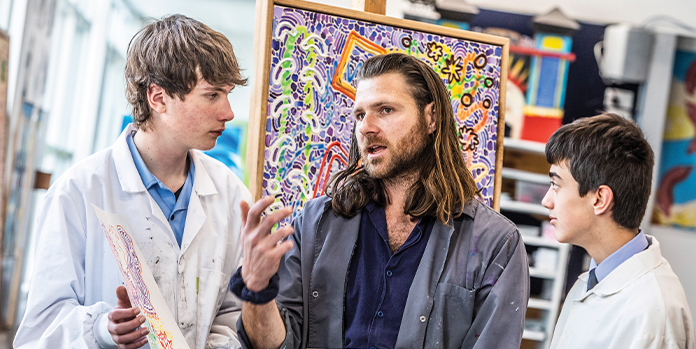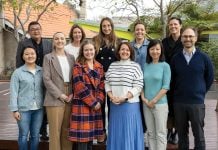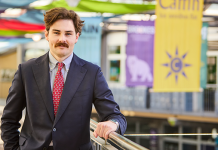Engaging with abstract art opens up exciting avenues for students to delve into visual representations from fresh and uncharted perspectives. It encourages individual interpretations of imagery, fostering an environment of acceptance for differing opinions and values. But it can be difficult for the untrained eye to appreciate the nuances of this style of art.
This is why Melbourne Grammar School invited Chris Jewitt, a renowned contemporary abstract artist, to undertake a six-week residency within Wadhurst this year. Chris guided Year 8 students through the creation of their own abstract piece of artwork, as well as a collaborative piece, all based on a simplified version of the layered approach which Chris uses in his professional practice.
Not every student will be a Picasso, but what is important is that students learn to recognise the significance of intention, narrative and technique in all art forms, including abstract art, according to Sam Sharpe, Coordinator of Visual Arts at Wadhurst.
“I’m beginning to understand abstract art and I definitely see why people find it intriguing now,” says Year 8 student Adrian Mirfield. “You often have to spend some time looking at the artwork to fully understand what the artist is trying to say. That makes it interesting.”
For fellow student Beare Reindel, his learning was centred on technique. “I made a couple of versions of my artwork because every single time I made one thing too small or one thing too big, and it just completely altered the entire painting. I hadn’t realised how important balance was.”
And it is not only the students who have learnt new ways of thinking during the Residency.
Chris says that, above all else, his objective was to demonstrate the value of creativity when it is combined with purpose. It’s deliberately challenging but, he hopes, as rewarding and illuminating for the students as it was for him.
“I think this form of work requires a huge leap of faith from the boys because abstract art is hard to understand. And it is hard to formulate an idea in an abstract form. At the heart of those abstractions is creativity. And I think it’s very necessary for students to utilise creativity and adapt it in different ways. Because no matter what occupation they end up in, it is creativity that will, I believe, make them stand out in some way.
“I think artists need to be able to really flesh out their own ideas and to be able to talk about those ideas. Experiences like this allow you to build that ability, I think. I’ve certainly learnt a lot from the boys, about my art, but also about the process of teaching and explaining.”



